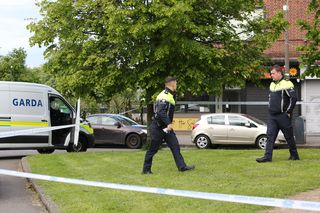Father of ex-Limerick GAA star crushed to death when ‘unsafe’ one-tonne automatic gate shut on him, inquest finds
James ‘Jim’ O’Carroll, father of footballer Seamus O’Carroll, died as he entered workplace at council yard


The father of retired star Limerick footballer Seamus O’Carroll was “crushed” to death when an “unsafe” one-tonne automatic steel gate shut on him as he attempted to enter his workplace.
A warning about the potential dangers of automatic gates was raised by Health & Safety Authority inspector Helen McCarthy, who investigated the circumstances of James “Jim” O’Carroll’s death, as she gave evidence at his inquest.
Mr O’Carroll’s son, Seamus, who recently retired from the Limerick senior football team and is a garda in Dublin, excused himself from Limerick Coroner’s Court as evidence of his father’s fatal injuries were read into the record by Coroner John McNamara.
James O’Carroll (52) was employed by Limerick City and County Council for more than 20 years and worked as a road sweeper out of a machinery yard operated by the authority in Newcastle West.
Access to the yard was controlled by a one-tonne automatic steel gate, measuring six metres by four metres.
As Mr O’Carroll was usually the first person into the yard every morning he would activate the automatic gate by ringing a number from his mobile phone. The gate could also be activated by a key fob.
He would then proceed to place a wooden plank in front of a single sensor located on the inside the gate to break the sensor, so the gate would remain open for his colleagues.
Ms McCarthy said she had discovered this practice was “commonplace for many years” at the yard.
On April 14, 2015, Mr O’Carroll had arrived at the yard and attempted to enter the access gate on his bicycle, but, as he went to grab the wooden plank, the gate suddenly closed on him smashing his rib cage and shoulders. He died at the scene.
The fatal accident was captured on CCTV cameras at the yard.
Con Mulcahy from Tournafullla, a mechanic employed at the yard, was the first person to come upon the scene, he freed Mr O’Carroll and performed CPR on him until an ambulance arrived.
Garda Sergeant Mark Mannix said Seamus O’Carroll identified his father’s body to him at the morgue at University Hospital Limerick later that day.
Sergeant Mannix said gardai contacted the HSA and designated the gate was designated a “crime scene”.
Ms McCarthy said she determined that the council was operating an “unsafe” gate, as “the automatic gate had only one sensor inside the gate, and there was none on the outside wall which could have prevented this accident as it would have detected his [Mr O’Carroll’s] presence”.
HSA inspector Helen McCarthy. Photo: Brendan Gleeson
She said the gate did not have a “Leading Edge Protection” system “to detect an obstruction in its path, and, again, this could have prevented the accident”.
Ms McCarthy said another reason for the fatal accident was that “the automatic gate had a closing force of approximately one metric tonne which did not diminish until the [closing] cycle was complete, therefore the gate kept closing on the deceased even when he was trapped”.
“I also found Limerick City and County Council had not prepared a written risk assessment for the automatic gate.”
Ms McCarthy said she conducted “many interviews” with Mr O’Carroll’s co-workers who told her there were other previous “near misses” involving the gate causing damage to a truck, as well as an incident “involving another pedestrian employee”.
“Unfortunately these occurrence were not acted upon.....they were not documented, and therefore missed”, Ms McCarthy said.
She said she prepared a file for the DPP, which subsequently brought criminal proceedings against the council before Limerick Circuit Criminal Court in November 2021.
The local authority was convicted of breaches of the Safety, Health and Welfare at Work Act and fined €75,000 after it pleaded guilty to three charges arising out of Mr O’Carroll’s death, including failure to provide employees with safe access to the yard.
“From the CCTV footage you can see that as soon as the gate starts to open, he (Mr O’Carroll) attempts to enter and he bends down to pick up the wooden plank and he doesn’t realise that the gate has suddenly started to reverse its action and close upon him,” Ms McCarthy said.
“There was one sensor inside the gate, and what is worthy of note is that this is the minimal safety precaution with these gates, and unfortunately you will see this in many domestic and many commercial settings to this day.”
“The Health and Safety Authority has issued, on foot of this accident, and also on two previous occasions issued safety alerts advising the public to have two sensors and also to have Leading-Edge Protection on automatic gates, which when it detects an object or a person, it automatically bounces [the gate] back open to stops it closing in on top of the person.”
Ms McCarthy said: “In this case the gate was set up so that if you activated the gate the gate would open but if you activated it again, instead of continuing to open it would actually close”.
Ms McCarthy said she could not determine the actual reason for the gate closing on Mr O’Carroll, however it was possible his own mobile phone had re-activated the gate “when he put the phone back into his pocket”.
“It was unfortunately an accident waiting to happen,” she said.
Ms McCarthy also said that, at the time, it was possible to activate the gate “from anywhere in the world, an inch away, a mile away, a million miles away”.
One did not have to be standing near the gate to open and close it: “As long as there was a signal and the mobile number was registered to the place, you could be in Timbuktu and you could activate the gate.”
“It begs the question what is the safe operation of automatic gates, and the conclusion we have come to is that the safest mechanism – if you are using a mobile phone – is to have a full visual of the gate before you activate it,” she said.
She said many gates did not have this safe system “but the problem is you don't know if there is a child or a dog or whatever there, so this is certainly a precautionary tale”.
“The safest mode of operation would be to have a hold-to-run fob system, which means that you are literally standing in front of the gate and you point your fob at the gate and you have to hold your finger on the fob in order to keep it open.”
“But the problem is that in today’s society nobody wants to wait; we want to have instant access.”
A postmortem found death was “due to cardiac respiratory failure secondary to blunt injury to the chest”.
Coroner John McNamara, while commenting on the cause of death, said Mr O’Carroll died from “a crush injury in a one-metric-tonne gate”.
The jury returned a unanimous verdict of misadventure.
















